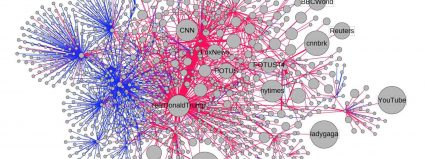Ever wondered why fascists hate free speech? Brains trumped brawn when this German art collective shined a light on dozens of violent neo-Nazis.
“Who Says Art Is Useless? A German Art Collective Outs 25 Neo-Nazis in an Online Sting Operation”
by Henri Neuendorf
Artnet News
December 8, 2018

A left-wing German art collective is using its creativity for a cause. The group’s members announced on Wednesday that they had identified dozens of neo-Nazis by luring them into an elaborate digital trap.
In August, far-right groups gathered in the east German city of Chemnitz for a multi-day rally that quickly turned violent. Fascist extremists chased and harassed immigrants, vandalized property, made Nazi salutes (which is illegal in Germany), and clashed with riot police. But most of the demonstrators who caused the unrest managed to evade arrest and prosecution.
In response, the leftist artist and activist group Center for Political Beauty (ZPS) made it their mission to bring as many neo-Nazi rioters to justice as possible. After the unrest, the activists began collecting footage and images of rioters and cross-referenced it with publicly available social media profiles.
The group built a website with information and pictures of more than 1,500 of the estimated 7,000 Chemnitz demonstrators and sent out a newsletter urging the public to come forward with further information. But the public appeal turned out to be a trick. Programmers working with ZPS deliberately designed the site so visitors could only see 20 profiles at a time, encouraging the fascists to use the search function to find out if they themselves had been named. Read more.

 Fake videos can now be created using a machine learning technique called a “generative adversarial network”, or a GAN. A graduate student, Ian Goodfellow, invented GANs in 2014 as a way to algorithmically generate new types of data out of existing data sets. For instance, a GAN can look at thousands of photos of Barack Obama, and then produce a new photo that approximates those photos without being an exact copy of any one of them, as if it has come up with an entirely new portrait of the former president not yet taken. GANs might also be used to generate new audio from existing audio, or new text from existing text – it is a multi-use technology.
Fake videos can now be created using a machine learning technique called a “generative adversarial network”, or a GAN. A graduate student, Ian Goodfellow, invented GANs in 2014 as a way to algorithmically generate new types of data out of existing data sets. For instance, a GAN can look at thousands of photos of Barack Obama, and then produce a new photo that approximates those photos without being an exact copy of any one of them, as if it has come up with an entirely new portrait of the former president not yet taken. GANs might also be used to generate new audio from existing audio, or new text from existing text – it is a multi-use technology. Aside from their role in amplifying the reach of misinformation, bots also play a critical role in getting it off the ground in the first place. According to the study, bots were likely to amplify false tweets right after they were posted, before they went viral. Then users shared them because it looked like a lot of people already had.
Aside from their role in amplifying the reach of misinformation, bots also play a critical role in getting it off the ground in the first place. According to the study, bots were likely to amplify false tweets right after they were posted, before they went viral. Then users shared them because it looked like a lot of people already had. The obituary that ran last week in Delaware Online is a mystery, the tale of a globe-trotting Renaissance man who disappeared in a single-engine plane over the Atlantic Ocean after learning he had cancer.
The obituary that ran last week in Delaware Online is a mystery, the tale of a globe-trotting Renaissance man who disappeared in a single-engine plane over the Atlantic Ocean after learning he had cancer.